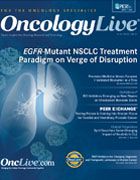Publication
Article
Oncology Live®
From Sidelines to Front Lines
Author(s):
One of the most gratifying aspects of the current age of discovery in anticancer therapy is the evolution of once-fatal malignancies into chronic diseases. The pace of progress, however, has not been equal across tumor types.
OncLive Chairman,
Mike Hennessy
One of the most gratifying aspects of the current age of discovery in anticancer therapy is the evolution of once-fatal malignancies into chronic diseases. The pace of progress, however, has not been equal across tumor types.
That is among the reasons that we are pleased to report advancements against 2 stubborn cancer types in this issue of OncologyLive®: triple- negative breast cancer (TNBC) and urothelial carcinoma.
In TNBC, the gains remain more in the realm of promising developments than new therapies ready for clinical use. Hope S. Rugo, MD, provides a comprehensive view of key areas under study in our cover story, “Signs of Progress Surface in TNBC.” These include novel agents that target the androgen receptor, inhibit PARP enzymes, and combine antibodies with cytotoxic drugs.
It will take several years to find out whether any of these strategies proves more effective than current chemotherapy regimens but early study findings suggest that progress is just a few years away.
In urothelial carcinoma, the most common form of bladder cancer, the checkpoint immunotherapy revolution that has generated so much excitement in other tumor types has finally arrived.
There is much irony in the fact that it has taken longer for the PD-1/PD-L1 pathway inhibitors to make their mark in bladder cancer than in other tumor types because the Bacillus Calmette-Guérin vaccine has played such an important role in the treatment of patients with nonmuscle invasive disease for more than 40 years.
Now, however, the pipeline is burst- ing with 2 newly approved and 3 rapidly developing drugs in advanced and metastatic settings, as we detail in our OncPathways® section in the article titled “Evidence Builds for Targeting PD-1/PD-L1 Pathway in Bladder Cancer.”
It is always precarious to celebrate too early when it comes to describing progress against cancer. This wily disease has so often outwitted therapies that seemed so promising in early-stage trials yet eventually faltered in phase III studies. On a road that is so frequently paved with disappointment, however, it is quite satisfying to be able to mark the positive milestones.
As always, thank you for reading.

































%20(2)%201-Recovered-Recovered-Recovered-Recovered-Recovered-Recovered-Recovered-Recovered-Recovered-Recovered-Recovered-Recovered-Recovered-Recovered-Recovered-Recovered-Recovered.jpg?fit=crop&auto=format)
%20(2)%201-Recovered-Recovered-Recovered-Recovered-Recovered-Recovered-Recovered-Recovered-Recovered-Recovered-Recovered-Recovered-Recovered-Recovered-Recovered-Recovered-Recovered.jpg?fit=crop&auto=format)
